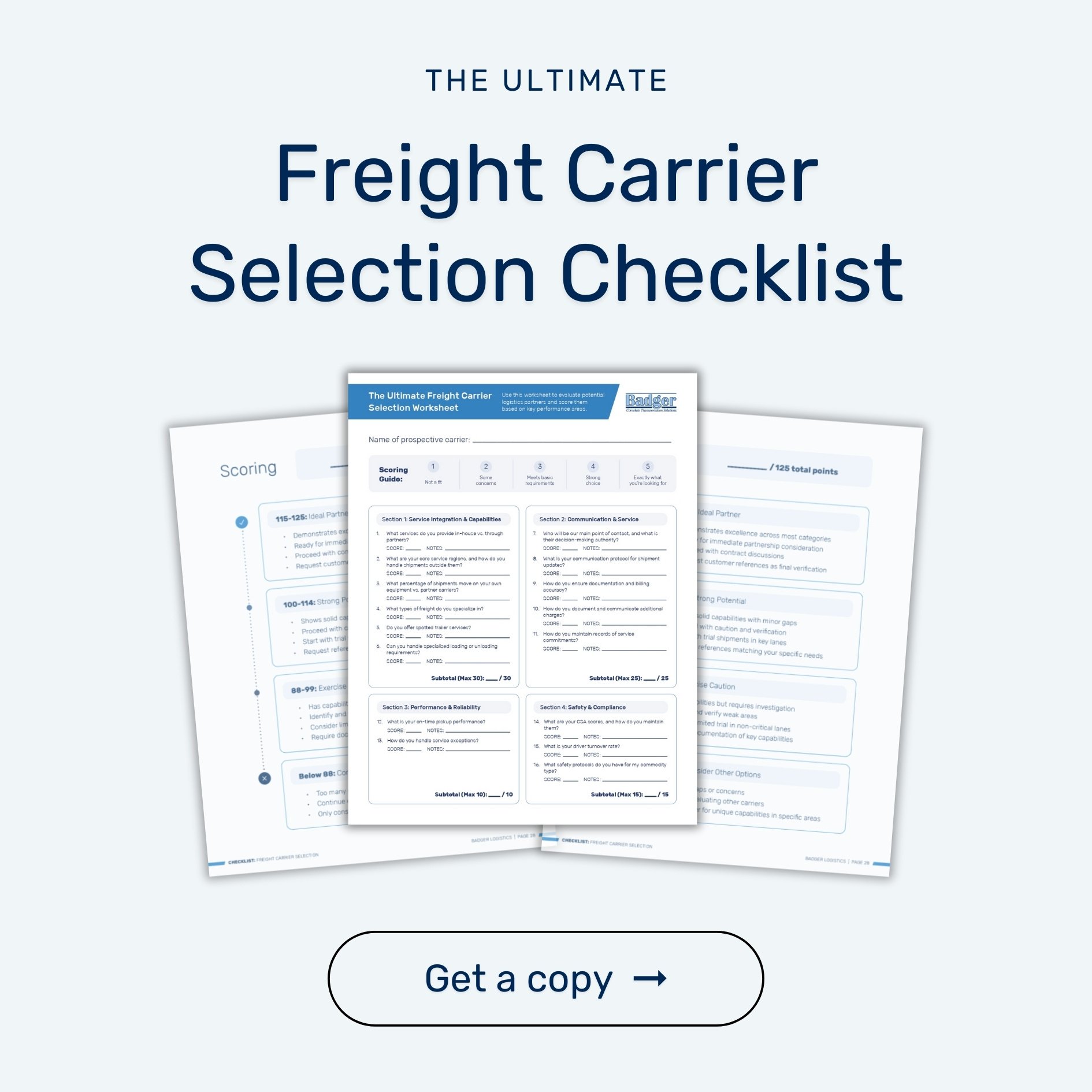Key takeaways
- Dry van shipping is the workhorse of freight transportation, using enclosed 53' trailers to protect non-temperature-sensitive goods from weather and road conditions.
- Standard dry vans can haul up to 45,000 pounds of cargo and provide approximately 3,500 cubic feet of space, making them ideal for palletized goods, consumer products, and industrial materials.
- Dry van shipping offers versatility, protection, cost-effectiveness, and widespread availability compared to specialized transportation options.
- When choosing a dry van carrier, evaluate their on-time performance (aim for 95%+), pickup reliability (99%+ is excellent), equipment quality, and problem-resolution capabilities.
- Look beyond rates to consider a carrier's safety scores, insurance coverage, communication protocols, and business stability for a true picture of their service quality.
Badger Logistics provides access to all trailer types through our asset-based fleet and extensive brokerage network, with expert consultation to match your freight with the optimal equipment. Contact us for competitive rates and reliable service across all equipment types.
What is dry van shipping?
Dry van shipping is the foundation of freight transportation in North America. It involves the use of enclosed, box-shaped trailers to transport non-temperature-sensitive goods. These trailers protect cargo from external elements while providing standardized dimensions that facilitate efficient loading, transportation, and unloading processes.
The term "dry van" distinguishes these standard enclosed trailers from refrigerated ("reefer") units, which include temperature control systems. Dry vans provide secure, weatherproof transportation without climate control functionality.
What is a dry van trailer?
A dry van trailer is a fully enclosed, non-climate-controlled rectangular trailer designed to transport general cargo. It is called "dry" because it lacks refrigeration or temperature control, distinguishing it from refrigerated (or "reefer") trailers.
Standard dry van trailers conform to established industry specifications:
|
The advantages of dry van shipping
Dry van shipping maintains its dominant position in the transportation industry due to several compelling advantages:
|
What can be shipped in dry vans?
Dry van trailers accommodate a comprehensive range of freight categories. Here are some of the most common but by no means the only types of freight.
|
At Badger Logistics, our extensive experience covers all these categories and more. The versatility of dry van shipping represents one of its primary advantages in the transportation marketplace. Our team can quickly determine whether your specific products are suitable for dry van transportation.
When dry van shipping may not be suitable
While dry vans offer exceptional versatility, certain shipments require alternative equipment. Understanding these limitations helps identify situations where other transportation modes become necessary:
Temperature-sensitive goods
Products requiring specific temperature ranges during transit need refrigerated (reefer) equipment rather than dry vans. This includes:
- Fresh produce and perishable foods
- Frozen products
- Pharmaceuticals with temperature requirements
- Chemicals with temperature-sensitivity
- Electronics that require climate control
Dry van interiors experience significant temperature fluctuations, potentially exceeding 100°F in summer and dropping well below freezing in winter, particularly in the Midwest region. They provide no insulation or temperature regulation capabilities.
Oversized or irregularly shaped items
Dry vans have fixed dimensional constraints that cannot accommodate oversized freight:
- Items exceeding 101.5 inches in width
- Items exceeding 110 inches in height
- Items exceeding 53 feet in length
- Items with irregular dimensions that prevent efficient trailer loading
Such shipments typically require flatbed, step deck, RGN, or specialized equipment options.
Extremely heavy freight
While dry vans technically accommodate up to 45,000 pounds, weight distribution remains critical. Single equipment pieces or concentrated loads may require specialized equipment despite falling within overall weight parameters.
The legal gross vehicle weight limit of 80,000 pounds (including tractor and trailer weight) creates practical payload limitations. After accounting for tractor weight (approximately 17,000 pounds) and trailer weight (approximately 14,000 pounds), the effective payload capacity typically ranges between 45,000-49,000 pounds.
Hazmat with special requirements
Many hazardous materials can move in dry vans with proper documentation, placarding, and handling protocols. However, certain hazardous material categories require specialized equipment, ventilation systems, or handling procedures that standard dry vans cannot provide.
Hazardous material transportation requires precise classification knowledge and compliance with applicable regulations to determine appropriate equipment selection.
Full truckload (FTL) vs. partial (PTL) in dry van shipping
Dry van capacity utilization follows two primary models, each offering distinct advantages depending on shipment characteristics:
Full truckload dry vanFull truckload service dedicates an entire trailer to a single shipper's freight, regardless of whether the shipment occupies the entire available space. The vehicle travels directly from origin to destination without intermediate freight handling. FTL service proves advantageous when:
Badger Logistics provides reliable FTL service through our asset-based fleet throughout the Midwest region, with nationwide coverage available through our extensive brokerage network. |
Partial truckload dry vanPartial truckload service allows multiple shippers to share trailer capacity, creating an efficient middle ground between full truckload and traditional less-than-truckload (LTL) service.
Badger Logistics approaches partial shipments differently than traditional LTL carriers. Rather than utilizing a hub-and-spoke model with multiple handling points, our partial service often maintains freight on the same vehicle throughout transit, reducing handling events and associated damage risks. This approach delivers superior service quality compared to traditional LTL while maintaining significant cost advantages over FTL for appropriate shipment profiles. |
Best practices for dry van shipping
Effective dry van shipping requires attention to detail throughout the transportation process. These best practices enhance efficiency, reduce risk, and optimize transportation outcomes.
1. Prepare your cargo properly
Freight preparation significantly impacts transportation efficiency and safety:
|
2. Make sure your documentation is complete
Transportation documentation directly impacts operational efficiency and compliance:
|
3. Consider any seasonal planning you need to do
The transportation market experiences significant seasonal variations requiring proactive management:
|
4. Load and secure your freight strategically
Proper loading techniques significantly impact shipment safety and damage prevention:
|
Selecting the right dry van carrier or logistics partner

Carrier selection significantly impacts service quality, reliability, and overall transportation performance. Finding the right partner means looking beyond rates to evaluate several critical factors that determine long-term success.
When assessing potential dry van carriers, focus on these key areas:
Service integration and capabilities
The scope and depth of a carrier's service offerings directly affect their ability to meet your specific needs. Comprehensive service capabilities provide flexibility when shipping requirements change, which they inevitably do in today's dynamic business environment.
At Badger Logistics, we've developed a complete service portfolio that combines asset-based reliability with brokerage flexibility. Our asset-based operations focus primarily east of the Mississippi and Texas, while our brokerage division extends coverage nationwide. This integration allows us to serve your lanes regardless of market conditions consistently.
The right carrier should offer services that align with your operational needs and provide room for growth. Beyond basic transportation, consider whether features like trailer spotting, drop-and-hook operations, or complementary warehousing would benefit your supply chain. For many shippers, these value-added services dramatically improve efficiency and reduce overall logistics costs.
Industry experience with your specific freight type also merits consideration. Specialized knowledge often translates to better handling, fewer problems, and enhanced understanding of your unique requirements.
Questions to ask potential dry van carriers:
|
Performance and reliability
Objective performance metrics provide critical insight into what you can expect from a carrier partnership. Past performance strongly indicates future results, making these measurements essential to your evaluation process.
- On-time delivery represents the most visible performance metric, with industry leaders maintaining rates of 95% or higher. Badger Logistics' asset-based fleet achieves 97% on-time performance, significantly exceeding industry averages. However, pickup reliability deserves equal attention, as missed pickups can disrupt your entire operation. Leading carriers maintain pickup compliance above 99%.
- Claims frequency reveals how carefully a carrier handles freight and resolves issues when they occur. Badger Logistics maintains one of the industry's lowest claims ratios, typically processing only one or two claims annually across our entire operation.
Performance consistency matters more than occasional excellence. A carrier that delivers reliable service day after day provides greater value than one that alternates between exceptional performance and significant failures. When evaluating carriers, seek evidence of sustained reliability rather than isolated examples of success.
Questions to ask potential dry van carriers:
|
Safety and compliance
Safety performance indicates operational discipline and effective risk management. Beyond the ethical imperative of preventing injuries and accidents, safety directly impacts service reliability and your potential liability exposure.
Federal Motor Carrier Safety Administration (FMCSA) Compliance, Safety, Accountability (CSA) scores provide objective safety metrics across multiple categories. These publicly available ratings offer insight into a carrier's safety culture and compliance history. Lower scores represent better performance, and carriers exceeding FMCSA thresholds in multiple categories warrant careful scrutiny.
Equipment age and maintenance practices strongly correlate with service reliability. Modern, well-maintained equipment experiences fewer breakdowns and delivers better overall performance. At Badger Logistics, we maintain tractors on a 6-7 year replacement cycle and trailers on a 10-12 year schedule, ensuring our equipment meets the highest standards of reliability and safety.
Driver quality directly impacts both safety and service outcomes. Industry-average driver turnover approaches 100%, creating significant operational challenges and consistency issues. Higher-performing carriers like Badger Logistics maintain substantially lower turnover rates (approximately 40%), indicating better driver satisfaction, more experienced personnel, and more consistent service delivery.
Questions to ask potential dry van carriers:
|
Communication practices
A carrier's communication approach reveals much about their service philosophy and operational effectiveness. Effective communication prevents most transportation problems and quickly resolves those that do occur.
The best carriers offer visibility systems that match your specific needs. Some shippers want comprehensive real-time tracking, while others prefer scheduled updates or exception-only notification. At Badger Logistics, we tailor our communication to each customer's preferences, recognizing that information needs vary significantly between organizations.
How carriers handle unexpected developments—weather delays, equipment issues, or facility problems—often determines the ultimate success of a shipping partnership. Effective exception management combines proactive notification, creative problem-solving, and commitment to finding the best possible solution regardless of challenges encountered.
Transparency regarding limitations and challenges indicates a trustworthy partner. Carriers who communicate honestly, even when delivering unwelcome news, typically prove more reliable than those who make unrealistic promises they cannot fulfill.
Questions to ask potential dry van carriers:
|
The Badger Logistics advantage for dry van shipping

Since 1993, Badger Logistics has delivered reliable transportation solutions throughout North America. Our approach to dry van shipping combines asset-based reliability with extensive brokerage network flexibility to create comprehensive shipping solutions.
- Modern fleet: We operate modern 53' dry van trailers with plate floors providing 101.5" interior width. Our equipment undergoes rigorous maintenance programs, minimizing breakdown risks and associated delays.
- Strategic fleet management: Our tractors follow a 6-7 year replacement cycle, with trailers on a 10-12 year schedule. This approach maintains modern, reliable equipment that consistently meets all safety and performance standards.
- Nationwide coverage: We deliver service through both our asset-based operations (primarily serving regions east of the Mississippi and Texas) and our network of 15,000+ vetted carrier partners (providing nationwide coverage).
- Adaptable solutions: Whether your needs involve full truckload service or partial shipments, we provide solutions designed to optimize efficiency and minimize costs.
- Trailer spotting program: Qualifying customers can access our trailer spotting program, allowing loading according to your production schedule rather than driver availability, enhancing dock efficiency and operational planning.
Contact us today to discuss your transportation needs and discover how our dry van expertise can optimize your supply chain.








